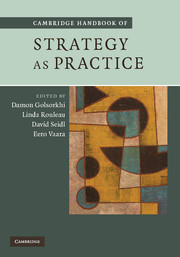Book contents
- Frontmatter
- Contents
- List of figures
- List of tables
- List of contributors
- Introduction: What is Strategy as Practice?
- PART I ONTOLOGICAL AND EPISTEMOLOGICAL QUESTIONS
- 1 Practice in research: phenomenon, perspective and philosophy
- 2 Epistemological alternatives for researching Strategy as Practice: building and dwelling worldviews
- 3 Practice, strategy making and intentionality: a Heideggerian onto-epistemology for Strategy as Practice
- 4 Constructivist epistemologies in Strategy as Practice research
- 5 Constructing contribution in ‘Strategy as Practice’ research
- 6 The challenge of developing cumulative knowledge about Strategy as Practice
- PART II THEORETICAL DIRECTIONS
- PART III METHODOLOGICAL TRACKS
- PART IV APPLICATION VARIATIONS
- Author Index
- Index
- References
4 - Constructivist epistemologies in Strategy as Practice research
Published online by Cambridge University Press: 05 October 2012
- Frontmatter
- Contents
- List of figures
- List of tables
- List of contributors
- Introduction: What is Strategy as Practice?
- PART I ONTOLOGICAL AND EPISTEMOLOGICAL QUESTIONS
- 1 Practice in research: phenomenon, perspective and philosophy
- 2 Epistemological alternatives for researching Strategy as Practice: building and dwelling worldviews
- 3 Practice, strategy making and intentionality: a Heideggerian onto-epistemology for Strategy as Practice
- 4 Constructivist epistemologies in Strategy as Practice research
- 5 Constructing contribution in ‘Strategy as Practice’ research
- 6 The challenge of developing cumulative knowledge about Strategy as Practice
- PART II THEORETICAL DIRECTIONS
- PART III METHODOLOGICAL TRACKS
- PART IV APPLICATION VARIATIONS
- Author Index
- Index
- References
Summary
Introduction
The practice turn in strategy research and the Strategy as Practice research programme (Johnson, Melin and Whittington 2003) imply an interest in explicitly reconsidering the epistemological and theoretical premises of conducting strategy research (Tsoukas and Knudsen 2002). Particularly, theories, methodologies and perspectives based on constructivist epistemologies play an important role, either explicitly or implicitly. Looking at main contributions to Strategy as Practice research over the last few years, a few patterns dominate (Johnson et al. 2007): on an empirical level, strategy and strategy making are seen as involving multiple processes and activities, with multiple actors distributed inside and outside the organization over multiple organizational layers. On a theoretical level, the study of strategy making as practice requires perspectives which grasp this heterogeneity of processes, activities and actors, and their situatedness, embeddedness and idiosyncrasy; it is argued that a focus on the practice of strategy making implies a discussion of the underlying action theories (Grand and McLean 2007; Jarzabkowski 2004; Tsoukas and Knudsen 2002). On an epistemological level, this emphasis on strategy making as practice requires a reflection of scientific research as practice (Knorr Cetina 2002).
In this chapter, we explore why an interest in strategy practice(s) promotes constructivist epistemologies by discussing important particularities and their relevance for strategy research. To focus our discussion, we ask one main question: How do constructivist epistemologies shape Strategy as Practice research? We explore this question in three steps. First, we introduce influential constructivist epistemologies, exploring their commonalities, idiosyncrasies and differences.
- Type
- Chapter
- Information
- Cambridge Handbook of Strategy as Practice , pp. 63 - 78Publisher: Cambridge University PressPrint publication year: 2010
References
- 4
- Cited by



